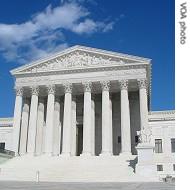Washington
01 October 2009
The U.S. Supreme Court opens its annual term Monday with a new justice and a new slate of potentially significant cases.
 |
| US Supreme Court (file photo) |
In recent years, the high court has considered an average of about 80 cases each year selected from about 8,000 requests for review.
Justice Sonia Sotomayor is the newest member of the high court, following her confirmation by the Senate in August. She is the first Hispanic justice on the nine-member court and is the second woman on the current court, joining Justice Ruth Bader Ginsburg.
Sotomayor recently told the CSPAN public affairs network that President Barack Obama asked her to make two promises shortly after accepting his offer for nomination to the Supreme Court.
"The first was to remain the person I was and the second was to stay connected to my community," she said. "And I said to him that those were two easy promises to make because those two things I could not change."
In the months ahead the Supreme Court will have an opportunity to render important judgments about gun rights, anti-terror laws, freedom of speech and punishment for juvenile criminals.
One of the most closely watched cases involves the rights of gun owners in the city of Chicago, where the city's ban on hand guns is being challenged by 2nd amendment advocates.
Last year, the court ruled the U.S. Constitution's 2nd amendment protects the right of an individual citizen to own a handgun in the District of Columbia, a federally governed enclave. Gun activists are hoping to use that five to four ruling by the Supreme Court to challenge local and state gun control laws around the country.
The high court has also agreed to hear a case involving part of an anti-terrorism law the government says is a vital part of its effort to fight international terrorism.
The law in question bars material support to groups designated by the U.S. government as terrorist organizations. But the statute is being challenged by the Kurdistan Workers Party in Turkey and the Tamil Tigers in Sri Lanka. Those groups say they are engaged in peaceful activities in the U.S. even though they have been designated as foreign terrorist organizations by the State Department.
The court is also scheduled to consider whether a law that prohibits pictures of animal cruelty constitutes a violation of free speech under the 1st Amendment to the U.S. Constitution.
In addition, the nine justices will also hear arguments about whether sentencing juveniles to life in prison without paroles for crimes other than murder violates the constitutional ban against cruel and unusual punishment.
Generally, five of the nine justices make up a conservative majority on the high court, including Chief Justice John Roberts.
Justice Sotomayor is expected to generally side with the liberal minority on court, following in the footsteps of the man she replaced, retired Justice David Souter.
Legal analysts will be watching to see how much the conservative majority on the court flexes its muscles. Doug Kendall is with the Constitutional Accountability Center, a liberal group that monitors the court.
"But I do think that this term is going to be an enormous test for Chief Justice Roberts and the conservatives on the court about these dramatic changes in the law that are being urged upon them and how they handle those and what principles guide their opinions, if any," said Kendall.
The high court is expected to rule soon on a case unresolved from last term involving long-standing restrictions on corporations and labor unions contributing to political candidates.